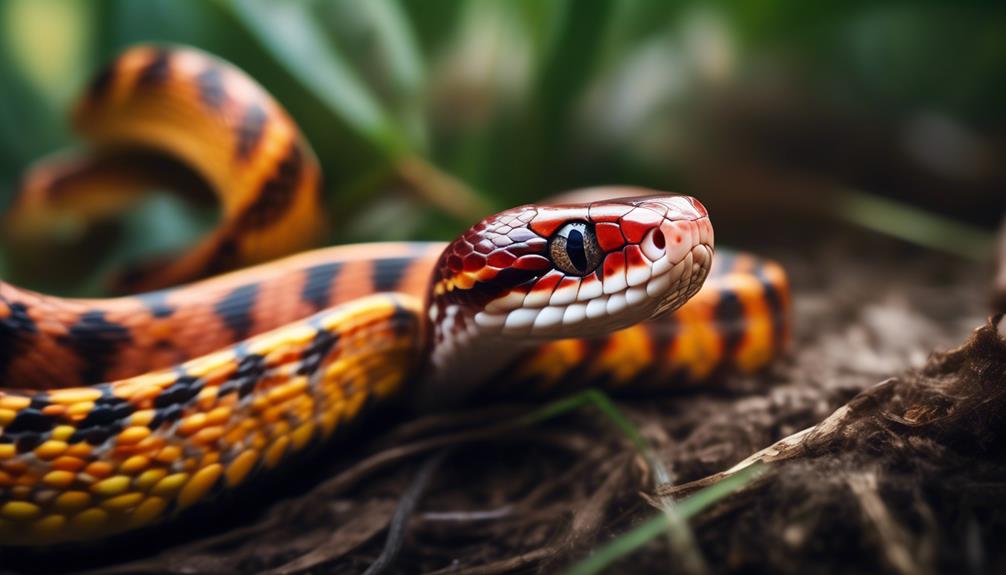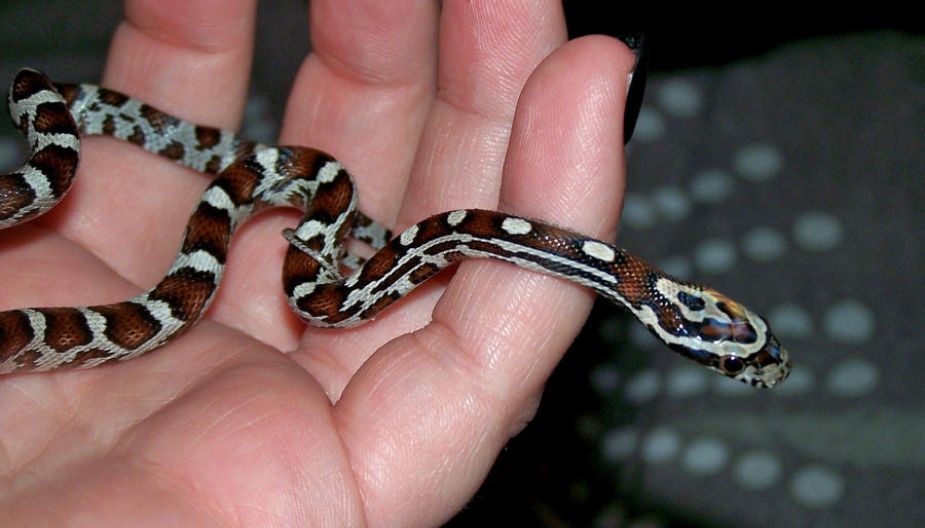You might be surprised to learn that many common beliefs about corn snakes are actually based on myths rather than facts. From their behavior to their care requirements, there are numerous misconceptions surrounding these fascinating reptiles.
But fear not, because in this discussion, we'll debunk these myths one by one, separating fact from fiction and providing you with a clearer understanding of what it's really like to own a corn snake.
So, let's unravel the truth behind these misconceptions and shed light on the reality of these captivating creatures.
Corn Snakes Are Venomous
Contrary to popular belief, corn snakes aren't venomous; they're harmless reptiles. Corn snakes are nonvenomous constrictors that subdue their prey through constriction. This means that they wrap around their prey and squeeze until the prey suffocates.
The misconception that corn snakes are venomous likely arises from their similar appearance to the venomous copperhead snake. However, it's important to note that corn snakes aren't only harmless to humans but also beneficial due to their role in controlling rodent populations.
Corn snakes are often found in the southeastern United States, where they play a vital role in the ecosystem by helping to keep rodent populations in check. Their nonvenomous nature makes them a popular choice among reptile enthusiasts as pets.
Understanding the distinction between venomous and nonvenomous snakes is crucial for anyone living in regions where these creatures are commonly found. By dispelling the myth that corn snakes are venomous, people can better appreciate and protect these fascinating reptiles.
Corn Snakes Are Aggressive
Corn snakes are typically docile and non-aggressive reptiles, known for their calm demeanor and reluctance to bite. Despite this, it's important to understand that individual snakes may exhibit defensive behaviors if they feel threatened or stressed. Here are some key points to consider about corn snake behavior:
- Handling techniques: When handling corn snakes, it's crucial to use gentle and calm movements. Avoid sudden, jerky motions that may startle the snake. Supporting their body securely with both hands can help them feel safe and reduce the likelihood of defensive behavior.
- Behavioral patterns: Corn snakes aren't aggressive by nature, but they may hiss, strike, or exhibit defensive postures if they feel threatened. It's essential to recognize their body language and respond accordingly to prevent them from feeling stressed or cornered.
- Understanding individual differences: While most corn snakes are docile, individual temperament can vary. Some may be more prone to defensive behaviors, especially if they haven't been properly socialized or handled with care.
- Patience and gradual acclimation: Introducing handling gradually and consistently can help corn snakes become accustomed to human interaction, reducing the likelihood of defensive responses. Consistent, gentle handling can help build trust and minimize stress for the snake.
Corn Snakes Are Difficult to Handle
When handling corn snakes, it's important to consider their behavior and individual differences, as this can impact the ease of their handling and acclimation to human interaction. Corn snakes are generally docile and can be easily handled with the right approach. Understanding their behavior and employing proper training techniques can make the handling process smooth and enjoyable for both you and the snake. Here are some handling tips and techniques to help you acclimate your corn snake to being handled:
| Handling Tips | Snake Behavior | Training Techniques |
|---|---|---|
| Start with short sessions | Understand individual temperament | Use positive reinforcement |
| Support the body properly | Recognize stress cues | Gradually increase handling time |
| Handle regularly | Provide hiding spots in enclosure | Be patient and consistent |
| Avoid sudden movements | Offer enrichment and mental stimulation | Use gentle, slow movements |
| Use a calm, confident approach | Monitor for signs of discomfort | Respect boundaries and cues |
It's also essential to ensure that the enclosure size is adequate for your corn snake, as a comfortable and secure environment can positively influence their behavior and ease of handling. By following these tips and understanding your snake's behavior, you can develop a strong bond and enjoy the rewarding experience of handling your corn snake.
Corn Snakes Require Large Enclosures
Ensuring that corn snakes are housed in large enclosures is essential to their well-being and overall health. Proper enclosure size is crucial for the physical and psychological well-being of corn snakes. Here's why:
- Enclosure Size: Corn snakes are active and curious creatures that require ample space to explore and move around. A larger enclosure allows them to exhibit natural behaviors such as climbing, burrowing, and exploring their environment.
- Thermoregulation: A spacious enclosure provides the opportunity for thermal gradient, allowing corn snakes to regulate their body temperature effectively. This is essential for their metabolic processes, digestion, and overall health.
- Behavioral Health: Inadequate space can lead to stress, anxiety, and behavioral issues in corn snakes. A larger enclosure promotes natural behaviors, reduces stress, and contributes to their overall well-being.
- Proper Handling: A larger enclosure allows for easier and less frequent handling, minimizing stress for the snake. It also provides space for enrichment activities, contributing to the snake's mental stimulation and well-being.
Corn Snakes Only Eat Live Prey
Properly understanding the dietary needs of corn snakes is crucial for their overall well-being and health, as it dispels the myth that corn snakes only eat live prey. In reality, corn snakes are known to thrive on a diet of appropriately sized frozen-thawed rodents. This feeding method not only meets their dietary needs but also eliminates the risk of injury from live prey. While it's true that corn snakes are skilled hunters, they don't require live prey to fulfill their nutritional requirements.
Corn snakes are constrictors, and their hunting behavior involves ambushing their prey by remaining motionless and then striking with precision. This natural instinct can be observed even when they're fed frozen-thawed prey, as they'll still exhibit their innate hunting behavior by striking at the prey and constricting it before consuming it.
Understanding the feeding habits and prey preferences of corn snakes is essential for their well-being. By offering frozen-thawed prey, you can ensure the nutritional needs of your pet corn snake are met while also minimizing potential risks associated with live prey, making it a safe and suitable option for feeding.
Conclusion
So there you have it, the truth about corn snakes.
Hopefully, you've learned that they aren't venomous, aggressive, or difficult to handle. In fact, they're quite gentle and easy to care for.
And as for their diet, they can be fed frozen or thawed prey, not just live prey.
So next time someone tries to tell you a wild myth about corn snakes, you can set them straight with the facts.
Happy herpetology!


